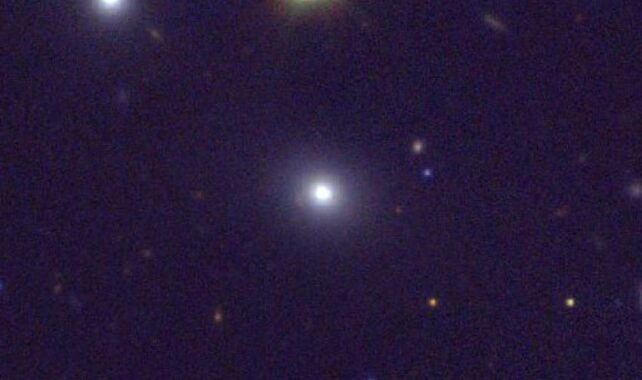Astronomers have observed a rare case of a galaxy shapeshifting.
A few decades ago, an object located some 630 million light-years away named PBC J2333.9-2343 was classified as a giant radio galaxy. It projected large, radio-emitting structures perpendicular to our line of sight, formed by colossal jets that once erupted from the galactic center.
More recent observations, however, reveal that the galaxy's core has switched back on, and is now aiming its jet directly towards us.
That's nothing to be alarmed about; in fact, it's fairly common. So common, in fact, we have a name for it; a blazar. With its new classification, the blazar PBC J2333.9-2343 could give us a deeper understanding of how galaxies can transform, even on human timescales.
Galaxies come in a range of shapes and sizes, but they also have different activity levels based on the activity of the supermassive black holes at their cores. The Milky Way, for instance, is a relatively peaceful galaxy; our supermassive black hole is fairly inactive, only accreting a small amount of material.
A supermassive black hole that is positively guzzling down dust and gas from its surrounding space looks very different. That material forms a torus and disk that circles the black hole; the extreme gravitational and frictional forces at play cause this disk to blaze with light across the entire electromagnetic spectrum.
From the inner edge of the disk, material falls onto the black hole, like water swirling down a drain. But not all that material ends up beyond the event horizon. Some of it is channeled away and accelerated along magnetic field lines outside the black hole. When it reaches the poles, this material is launched into space with tremendous speed, forming jets of plasma that erupt into space at a significant percentage of light speed in a vacuum.

When the black hole finishes its meal and quietens down again, what remains of those jets can continue to travel through space, spreading out into lobes that continue to emit radio waves. These are known as giant radio galaxies, and they can be colossal. PBC J2333.9-2343 has such radio lobes, evidence of past black hole activity, spanning a total distance of 3.9 million light-years.
But the galaxy has shown some odd behavior at different wavelengths, leading a team of astronomers led by astrophysicist Lorena Hernández-García of the Millenium Institute of Astrophysics in Chile to the notion that PBC J2333.9-2343 might now be a blazar. They published a paper laying out their argument in 2017, and now they've obtained the observational evidence to match.
"We started to study this galaxy as it showed peculiar properties," Hernández-García explains. "Our hypothesis was that the relativistic jet of its supermassive black hole had changed its direction, and to confirm that idea we had to carry out a lot of observations."
The research team conducted an extremely thorough investigation, collecting observations in radio, infrared, optical, ultraviolet, X-ray, and gamma-ray wavelengths. Then, they compared their observational data against a large database of blazar and non-blazar galaxies.
The results showed that J2333.9-2343's characteristics are more consistent with blazar galaxies, suggesting that the galaxy has somehow dramatically re-oriented by up to 90 degrees so that its black hole is aiming one of its jets in our direction.
"The fact that we see the nucleus is not feeding the lobes anymore means that they are very old," Hernández-García says. "They are the relics of past activity, whereas the structures located closer to the nucleus represent younger and active jets."
As for how the black hole could have changed position so dramatically, that is still unknown. There is a distinct lack of activity detected between the lobes and the galaxy, suggesting that the black hole was knocked sideways during a major event, such as a collision and merger with another galaxy.
In turn, this could mean that we are looking, for the first time, at what the researchers call a "very exceptional case of jet reorientation", transforming J2333.9-2343 and leading to its reclassification from a giant radio galaxy to a blazar.
The research has been published in the Monthly Notices of the Royal Astronomical Society.
